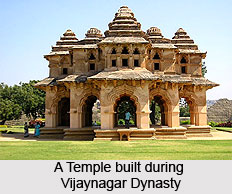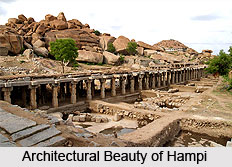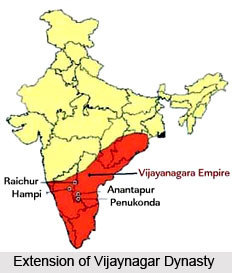 Vijayanagar Empire was a South Indian empire based in the Deccan. This empire lasted for three centuries and successfully prevented the extension of Muslim sultanates in south. The history of Vijayanagar is perhaps the last magnificent chapter in the history of independent India. Founded by Harihara I and his sibling Bukka Raya in 1336, the empire prolonged until 1646. The authority of the kingdom declined in the 1565 after a key military defeat by the Deccan Sultanates. Vijayanagar Empire is appropriately named after its capital city of Vijayanagar, the remarkable ruins of which surround modern href="https://www.indianetzone.com/3/hampi_karnataka.htm" class="fntlink" title="Hampi">Hampi, a World Heritage site in modern Karnataka, India. The literature in the local dialects accompanied by the inscriptions of medieval European travellers such as Domingo Paes, Fernao Nuniz and Niccol-Da-Conti endow with significant information regarding the region's history.Legacy of the Vijayanagar Empire
Vijayanagar Empire was a South Indian empire based in the Deccan. This empire lasted for three centuries and successfully prevented the extension of Muslim sultanates in south. The history of Vijayanagar is perhaps the last magnificent chapter in the history of independent India. Founded by Harihara I and his sibling Bukka Raya in 1336, the empire prolonged until 1646. The authority of the kingdom declined in the 1565 after a key military defeat by the Deccan Sultanates. Vijayanagar Empire is appropriately named after its capital city of Vijayanagar, the remarkable ruins of which surround modern href="https://www.indianetzone.com/3/hampi_karnataka.htm" class="fntlink" title="Hampi">Hampi, a World Heritage site in modern Karnataka, India. The literature in the local dialects accompanied by the inscriptions of medieval European travellers such as Domingo Paes, Fernao Nuniz and Niccol-Da-Conti endow with significant information regarding the region's history.Legacy of the Vijayanagar EmpireThe empire's support facilitated fine arts and literature in order to attain new-fangled pinnacles in Kannada, Telugu, Tamil and Sanskrit languages, while Carnatic Music advanced into its existing structure. The Vijayanagar Empire shaped an era in South Indian history thereby surpassing regionalism with the promotion of Hinduism as a coalescing feature. The empire's legacy includes many monuments, the best known of which is the group of monuments at Hampi. Multiple temple building traditions in South and Central India were synthesised in the Vijayanagara Architecture style. This synthesis inspired the architecture of the Hindu temples’ construction. Efficient functioning of the administration and overseas trade brought new technologies such as water management systems for irrigation.
 History of Vijayanagar Empire
History of Vijayanagar EmpireSeveral theories have been projected claiming the basis of the Vijayanagar Empire. A few assert that Harihara I and Bukka Raya I, the originators of the kingdom, were the ones primarily allied to the Kakatiya dynasty who acquired power of the northern regions of the Hoysala Empire through its decline. Further, historians put forth that they were Kannadigas and commanders in the army of the Hoysala Empire posted in the Tungabhadra River region to charge off Muslim incursions commencing from Northern India. Irrespective of their derivation, historians concur that the initiators were backed and enthused by Vidyaranya, a saint at the Sringeri monastery to wrestle the Muslim incursion of South India. Inscriptions by foreign travellers during the late medieval era pooled with topical excavations in the Vijayanagar region have revealed the required details concerning the empire’s history, ramparts, scientific expansions and architectural advancements.Before the early 14th-century rise of the Vijayanagara Empire, the Hindu states of the Deccan – the Yadava Empire of Devagiri, the Kakatiya dynasty of Warangal, the Pandyan Empire of Madurai were raided and attacked by Muslims from the north. By the year 1336 the upper Deccan region (modern day Telangana and Maharashtra) had been defeated by armies of Alauddin Khilji and Muhammad bin Tughluq of the Delhi Sultanate.
 Governance of the Vijayanagar Empire
Governance of the Vijayanagar EmpireIn Vijayanagar, the King was the ultimate authority and he was assisted by a cabinet of pradhanas headed by a Mahapradhana. All high-ranking ministers and officers were required to have proper military training. A secretariat was appointed near the king's palace which employed officers to maintain records. At the lower administrative levels, wealthy feudal landlords (Goudas) looked over the work of the accountants (Karanikas or Karnam) and guards (Kavalu). The palace administration was divided into 72 departments each of them having several female attendants who were trained to handle minor administrative matters. The whole empire was divided into five main rajyas each of which was further divided into regions. The regions were divided into counties with the subdivision of municipalities. The capital city of this empire was totally dependent upon the water supply system. Contemporary inscription of that time brought the fact that huge tanks were constructed by the labours.
For more, visit the link below:
https://www.indianetzone.com/3/the_vijayanagar_empire.htm